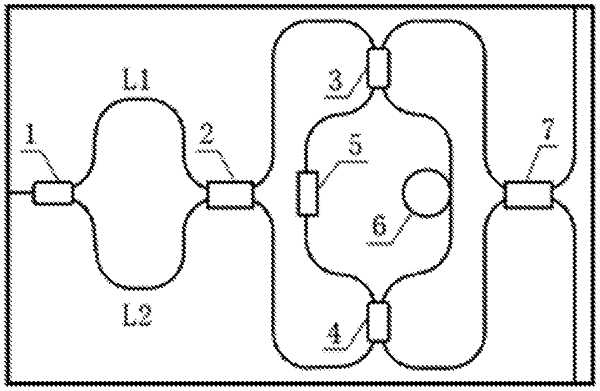| CPC H04B 10/614 (2013.01) [G02B 6/272 (2013.01); G02B 6/2773 (2013.01); H04B 10/612 (2013.01); H04B 10/6151 (2013.01)] | 12 Claims |

|
1. A polarization independent differential quadrature phase shift keying (DQPSK) demodulation integrated optical chip, comprising: a first beam splitter, a first polarization beam splitter rotator, a second beam splitter, a third beam splitter, a first quarter-wave plate, a first delayed optical waveguide, and a second polarization beam splitter rotator, all of which are integrated on a same substrate,
two output ports of the first beam splitter are respectively connected to two input ports of the first polarization beam splitter rotator through a first optical waveguide and a second optical waveguide; wherein two output ports of the first polarization beam splitter rotator are respectively connected to one of two input ports of the second beam splitter and one of two input ports of the third beam splitter through third optical waveguides; two input ports of the second polarization beam splitter rotator are respectively connected to a second one of the two input ports of the second beam splitter and a second one of the two input ports of the third beam splitter through fourth optical waveguides; two output ports of the second beam splitter are respectively connected to two output ports of the third beam splitter through the first quarter-wave plate and the first delayed optical waveguide, to form a delay interferometer;
the first beam splitter is configured to split an input signal optical to generate a first signal optical component and a second signal optical component;
the first polarization beam splitter rotator is configured to perform a polarization beam splitting on the first signal optical component incident to one of the two input ports of the first polarization beam splitter rotator to generate a first polarization component and a second polarization component, both of which are transverse-electric (TE) polarized; and to perform the polarization beam splitting on the second signal optical component incident to a second one of the two input ports of the first polarization beam splitter rotator to generate a third polarization component and a fourth polarization component, both of which are transverse-magnetic (TM) polarized;
the delay interferometer is configured to perform a delayed self-interference on the first polarization component incident to the one of the two input ports of the second beam splitter to generate a first interference component and a second interference component to be emitted from the two input ports of the third beam splitter, respectively; and to perform the delayed self-interference on the second polarization component incident to the second one of the two input ports of the third beam splitter to generate a third interference component and a fourth interference component to be emitted from the two input ports of the second beam splitter, respectively;
the delay interferometer is further configured to perform the delayed self-interference on the third polarization component incident to the one of the two input ports of the second beam splitter to generate a fifth interference component and a sixth interference component to be emitted from the two input ports of the third beam splitter, respectively; and to perform the delayed self-interference on the fourth polarization component incident to the second one of the two input ports of the third beam splitter to generate a seventh interference component and an eighth interference component to be emitted from the two input ports of the second beam splitter, respectively;
a main axis direction of the first quarter-wave plate has an angle of 0° with TE polarization, such that a phase of a TM polarized optical signal is increased by π/2 and a phase of a TE polarized optical signal remains unchanged when passing through the first quarter-wave plate;
the first delayed optical waveguide is configured to increase delay of a passing optical signal by τ;
the first polarization beam splitter rotator is further configured to perform a polarization and beam combination on the first interference component and the third interference component, both of which are TE polarized, to generate a first interference optical signal; and to perform the polarization and beam combination on the fifth interference component and the seventh interference component, both of which are TM polarized, to generate a third interference optical signal;
the second polarization beam splitter rotator is configured to perform the polarization and beam combination on the second interference component and the fourth interference component, both of which are TE polarized, to generate a second interference optical signal; and to perform the polarization and beam combination on the sixth interference component and the eighth interference component, both of which are TM polarized, to generate a fourth interference optical signal.
|